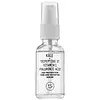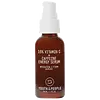What's inside
What's inside
 Key Ingredients
Key Ingredients

 Benefits
Benefits

 Concerns
Concerns

 Ingredients Side-by-side
Ingredients Side-by-side

Water
Skin ConditioningLactic Acid
BufferingCitric Acid
BufferingMalic Acid
BufferingGlycerin
HumectantPalmitoyl Tripeptide-5
Skin ConditioningMagnesium Ascorbyl Phosphate
AntioxidantButylene Glycol
HumectantBrassica Oleracea Acephala Leaf Extract
HumectantSpinacia Oleracea Leaf Extract
Skin ConditioningCamellia Sinensis Leaf Extract
AntimicrobialChamomilla Recutita Flower Extract
MaskingMedicago Sativa Leaf Extract
Skin ConditioningAloe Barbadensis Leaf Extract
EmollientSodium Hyaluronate Crosspolymer
HumectantPanthenol
Skin ConditioningHeptyl Glucoside
Hydroxyethylcellulose
Emulsion StabilisingSodium Hyaluronate
HumectantParfum
MaskingSuperoxide Dismutase
AntioxidantTyrosine
MaskingSodium Citrate
BufferingMagnesium Chloride
Pentylene Glycol
Skin ConditioningEthylhexylglycerin
Skin ConditioningPhenoxyethanol
PreservativePotassium Sorbate
PreservativeSodium Benzoate
MaskingWater, Lactic Acid, Citric Acid, Malic Acid, Glycerin, Palmitoyl Tripeptide-5, Magnesium Ascorbyl Phosphate, Butylene Glycol, Brassica Oleracea Acephala Leaf Extract, Spinacia Oleracea Leaf Extract, Camellia Sinensis Leaf Extract, Chamomilla Recutita Flower Extract, Medicago Sativa Leaf Extract, Aloe Barbadensis Leaf Extract, Sodium Hyaluronate Crosspolymer, Panthenol, Heptyl Glucoside, Hydroxyethylcellulose, Sodium Hyaluronate, Parfum, Superoxide Dismutase, Tyrosine, Sodium Citrate, Magnesium Chloride, Pentylene Glycol, Ethylhexylglycerin, Phenoxyethanol, Potassium Sorbate, Sodium Benzoate
Water
Skin Conditioning3-O-Ethyl Ascorbic Acid
Skin ConditioningTetrahexyldecyl Ascorbate
AntioxidantPropanediol
SolventGlycerin
HumectantPentylene Glycol
Skin ConditioningSodium Citrate
BufferingSqualane
EmollientTriethyl Citrate
MaskingGluconolactone
Skin ConditioningCitric Acid
BufferingPolyhydroxystearic Acid
EmulsifyingPolyglyceryl-6 Polyricinoleate
EmulsifyingXanthan Gum
EmulsifyingSodium Hyaluronate
HumectantCaffeine
Skin ConditioningMagnesium Ascorbyl Phosphate
AntioxidantSodium Stearoyl Glutamate
CleansingSodium Benzoate
MaskingLauroyl Lysine
Skin ConditioningPassiflora Edulis Fruit Extract
Skin ConditioningSclerotium Gum
Emulsion StabilisingLecithin
EmollientIlex Guayusa Leaf Extract
Skin ProtectingIlex Paraguariensis Leaf Extract
PerfumingPullulan
Mannitol
HumectantHylocereus Undatus Fruit Extract
Skin ConditioningZingiber Officinale Root Oil
MaskingCalcium Gluconate
HumectantSilica
AbrasivePotassium Sorbate
PreservativePhenoxyethanol
PreservativeErgothioneine
AntioxidantWater, 3-O-Ethyl Ascorbic Acid, Tetrahexyldecyl Ascorbate, Propanediol, Glycerin, Pentylene Glycol, Sodium Citrate, Squalane, Triethyl Citrate, Gluconolactone, Citric Acid, Polyhydroxystearic Acid, Polyglyceryl-6 Polyricinoleate, Xanthan Gum, Sodium Hyaluronate, Caffeine, Magnesium Ascorbyl Phosphate, Sodium Stearoyl Glutamate, Sodium Benzoate, Lauroyl Lysine, Passiflora Edulis Fruit Extract, Sclerotium Gum, Lecithin, Ilex Guayusa Leaf Extract, Ilex Paraguariensis Leaf Extract, Pullulan, Mannitol, Hylocereus Undatus Fruit Extract, Zingiber Officinale Root Oil, Calcium Gluconate, Silica, Potassium Sorbate, Phenoxyethanol, Ergothioneine
 Reviews
Reviews

Ingredients Explained
These ingredients are found in both products.
Ingredients higher up in an ingredient list are typically present in a larger amount.
Citric Acid is an alpha hydroxy acid (AHA) naturally found in citrus fruits like oranges, lemons, and limes.
Like other AHAs, citric acid can exfoliate skin by breaking down the bonds that hold dead skin cells together. This helps reveal smoother and brighter skin underneath.
However, this exfoliating effect only happens at high concentrations (20%) which can be hard to find in cosmetic products.
Due to this, citric acid is usually included in small amounts as a pH adjuster. This helps keep products slightly more acidic and compatible with skin's natural pH.
In skincare formulas, citric acid can:
While it can provide some skin benefits, research shows lactic acid and glycolic acid are generally more effective and less irritating exfoliants.
Most citric acid used in skincare today is made by fermenting sugars (usually from molasses). This synthetic version is identical to the natural citrus form but easier to stabilize and use in formulations.
Read more about some other popular AHA's here:
Learn more about Citric AcidGlycerin is already naturally found in your skin. It helps moisturize and protect your skin.
A study from 2016 found glycerin to be more effective as a humectant than AHAs and hyaluronic acid.
As a humectant, it helps the skin stay hydrated by pulling moisture to your skin. The low molecular weight of glycerin allows it to pull moisture into the deeper layers of your skin.
Hydrated skin improves your skin barrier; Your skin barrier helps protect against irritants and bacteria.
Glycerin has also been found to have antimicrobial and antiviral properties. Due to these properties, glycerin is often used in wound and burn treatments.
In cosmetics, glycerin is usually derived from plants such as soybean or palm. However, it can also be sourced from animals, such as tallow or animal fat.
This ingredient is organic, colorless, odorless, and non-toxic.
Glycerin is the name for this ingredient in American English. British English uses Glycerol/Glycerine.
Learn more about GlycerinMagnesium Ascorbyl Phosphate (MAP) is a form of Vitamin C and is an antioxidant. It can help to reduce redness, improve skin texture, reduce the effects of aging, reduce the visibility of dark spots, and brighten skin.
MAP is created by combining ascorbic acid with magnesium salt. While MAP more gentle on the skin than ascorbic acid, it is thought to be less easily-absorbed into the skin.
Due to MAP's stability up to a pH level of 7, it is more stable to air and sunlight exposure than ascorbic acid. The best pH range for MAP is between 5 and 6.
Like other forms of Vitamin C, MAP has been shown to help reduce hyperpigmentation and simulate collagen production.
As an antioxidant, it helps protect your skin against the signs of aging.
Learn more about Magnesium Ascorbyl PhosphatePentylene glycol is typically used within a product to thicken it. It also adds a smooth, soft, and moisturizing feel to the product. It is naturally found in plants such as sugar beets.
The hydrophilic trait of Pentylene Glycol makes it a humectant. As a humectant, Pentylene Glycol helps draw moisture from the air to your skin. This can help keep your skin hydrated.
This property also makes Pentylene Glycol a great texture enhancer. It can also help thicken or stabilize a product.
Pentylene Glycol also acts as a mild preservative and helps to keep a product microbe-free.
Some people may experience mild eye and skin irritation from Pentylene Glycol. We always recommend speaking with a professional about using this ingredient in your routine.
Pentylene Glycol has a low molecular weight and is part of the 1,2-glycol family.
Learn more about Pentylene GlycolPhenoxyethanol is a preservative that has germicide, antimicrobial, and aromatic properties. Studies show that phenoxyethanol can prevent microbial growth. By itself, it has a scent that is similar to that of a rose.
It's often used in formulations along with Caprylyl Glycol to preserve the shelf life of products.
Potassium Sorbate is a preservative used to prevent yeast and mold in products. It is commonly found in both cosmetic and food products.
This ingredient comes from potassium salt derived from sorbic acid. Sorbic acid is a natural antibiotic and effective against fungus.
Both potassium sorbate and sorbic acid can be found in baked goods, cheeses, dried meats, dried fruit, ice cream, pickles, wine, yogurt, and more.
You'll often find this ingredient used with other preservatives.
Learn more about Potassium SorbateSodium Benzoate is a preservative. It's used in both cosmetic and food products to inhibit the growth of mold and bacteria. It is typically produced synthetically.
Both the US FDA and EU Health Committee have approved the use of sodium benzoate. In the US, levels of 0.1% (of the total product) are allowed.
Sodium benzoate works as a preservative by inhibiting the growth of bacteria inside of cells. It prevents the cell from fermenting a type of sugar using an enzyme called phosphofructokinase.
It is the salt of benzoic acid. Foods containing sodium benzoate include soda, salad dressings, condiments, fruit juices, wines, and snack foods.
Studies for using ascorbic acid and sodium benzoate in cosmetics are lacking, especially in skincare routines with multiple steps.
We always recommend speaking with a professional, such as a dermatologist, if you have any concerns.
Learn more about Sodium BenzoateSodium Citrate is the sodium salts of citric acid. In skincare, it is used to alter pH levels and acts as a preservative.
Its main functions are to maintain the pH of a product and neutralize metal ions.
The acidity of our skin is maintained by our glands and skin biome; normal pH level of skin is slightly acidic (~4.75-5.5).
Being slightly acidic allows our skin to create an "acid mantle". This acid mantle is a thin barrier that protects our skin from bacteria and contaminants.
Learn more about Sodium CitrateSodium Hyaluronate is hyaluronic acid's salt form. It is commonly derived from the sodium salt of hyaluronic acid.
Like hyaluronic acid, it is great at holding water and acts as a humectant. This makes it a great skin hydrating ingredient.
Sodium Hyaluronate is naturally occurring in our bodies and is mostly found in eye fluid and joints.
These are some other common types of Hyaluronic Acid:
Learn more about Sodium HyaluronateWater. It's the most common cosmetic ingredient of all. You'll usually see it at the top of ingredient lists, meaning that it makes up the largest part of the product.
So why is it so popular? Water most often acts as a solvent - this means that it helps dissolve other ingredients into the formulation.
You'll also recognize water as that liquid we all need to stay alive. If you see this, drink a glass of water. Stay hydrated!
Learn more about Water